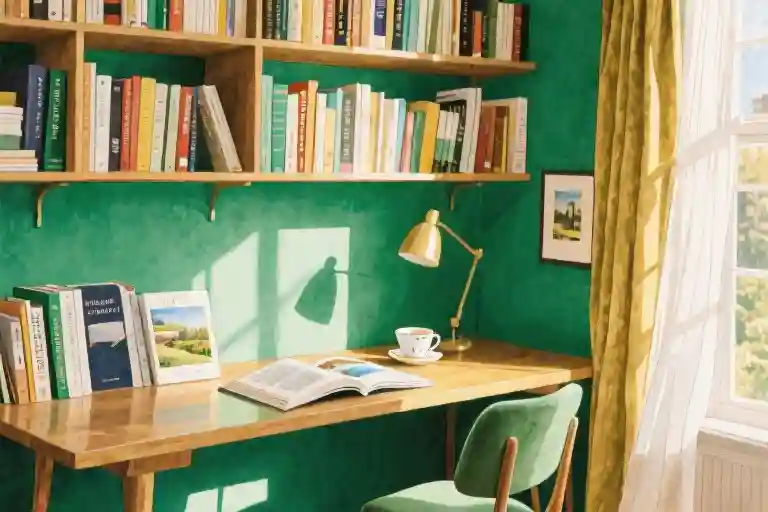The wallpaper was peeling at the edges when I first noticed the silence. Two years ago, my life had the distinct quality of a half-empty house – the kind where you keep the guest towels perfectly folded, just in case someone might visit. At 37, freshly single with a quiet ring finger and a biological clock that had transitioned from ticking to tolling, I found myself cataloging my failures like mismatched silverware.
What surprised me most wasn’t the heartbreak (that was familiar territory), but the sheer physical weight of the word ‘spinster’ as it settled between my shoulder blades each morning. My London flat, which had always felt cozy, suddenly seemed to mock me with its single-occupancy proportions. The second bedroom I’d used as a yoga space became a Rorschach test – was it a future nursery or just proof I’d overpaid for square footage?
Then came the renovation plans. Standing in the architect’s office clutching my cracked teacup (how fitting), I realized every decision had become a referendum on my romantic future. Should we extend the kitchen for hypothetical dinner parties? Convert the loft into a master suite worthy of coupledom? The contractor’s innocent question – “Will you be needing child-safe railings?” – left me breathless in the way only truly mundane heartbreaks can.
What no one tells you about being suddenly single in your late thirties is how physical the experience becomes. The body keeps score in unexpected ways – the hollow behind your knees when you climb into an empty bed, the way your ribs start to ache from holding your breath during pregnancy announcements. I developed actual calluses from gripping my phone too tightly during yet another ‘So any special someone?’ interrogation at family gatherings.
But here’s the curious thing they don’t put in those ‘How to Survive Being Single’ listicles: Rock bottom makes for excellent foundation work. That house I couldn’t bear to renovate for one? It’s now got a writing nook where the nursery plans used to be, with shelves precisely spaced for my collection of travel memoirs instead of baby books. The guest room has morphed into a proper studio where friends come to paint bad watercolors and drink worse wine. Somewhere between choosing brass fixtures over babyproofing and writing my first personal essay, I discovered an unexpected truth – there’s a particular freedom in designing your life without leaving room for hypothetical people.
This isn’t one of those miraculous turnaround stories. The metamorphosis from ‘spinster’ to self-possessed took 732 days (but who’s counting?), approximately 47 tearful calls to my sister, and one spectacularly disastrous first attempt at online dating. What emerged wasn’t some polished, Instagram-ready version of single bliss, but something far more interesting – a life built deliberately, awkwardly, unapologetically around the person I actually was, rather than the one I thought I should become for someone else’s benefit.
When Hope Becomes a Prison
The blueprint spread across my kitchen table showed a three-bedroom layout with a proposed loft conversion. My architect’s pencil hovered over the empty space labeled ‘Bedroom 3/Nursery.’ ‘We could easily add built-in storage here,’ she said, ‘or even convert it to a proper bedroom later if…’ Her voice trailed off in that particular way people do when mentioning futures they assume you want but aren’t sure you’ll have.
I stared at the dotted lines representing walls that didn’t yet exist, mentally furnishing a room for a child who might never arrive. At 37, freshly single after a five-year relationship ended, I found myself making calculations no man in my position would consider – measuring windowsills for hypothetical baby monitors while simultaneously estimating my declining fertility. The cognitive dissonance left nail marks in my palms.
The Tyranny of ‘Just in Case’
Every decision carried invisible weight. Choosing hardwood floors meant considering future toddler spills. The open-plan living area needed evaluation through the lens of ‘family-friendly.’ Even paint colors became loaded – would potential partners find mint green too juvenile? I’d become trapped in what behavioral economists call ‘maximizer mode,’ endlessly optimizing for a life scenario that required another person’s participation while my actual life waited on hold.
My married friends didn’t face this paralysis. Their home renovations flowed from present reality: ‘We need an office’ or ‘The kids want a playroom.’ My plans all contained silent parentheticals: (if I meet someone) (if we have time) (if it’s not too late). The constant mental hedging drained more energy than the actual demolition work.
The Questions That Aren’t Questions
‘Are you keeping the guest room as-is?’ my mother asked during one site visit, her eyes flickering toward the smallest bedroom. Translation: Will there be space for grandchildren? At dinner parties, newly pregnant friends would sigh, ‘You’re so lucky to be doing this renovation – you can design exactly what you want!’ Their tone suggested this was consolation for not designing a nursery instead.
Even well-meaning comments reinforced the narrative that my choices were temporary accommodations until real life began. When I mentioned converting the would-be nursery into a writing studio, the most common response wasn’t ‘What will you write?’ but ‘That’s smart – easy to convert back later.’ As if creating something permanent for myself required an escape hatch.
The Suspended Animation of Waiting
I realized I’d been living in architectural limbo – furnishing temporary emotional housing while waiting for someone else to bring the blueprints for my real life. The spare bedroom stayed half-empty ‘just in case.’ Vacation plans remained unbooked in case a partner preferred different dates. Career moves got delayed awaiting some mythical stability that never came.
This went beyond singleness. It was a wholesale outsourcing of agency, as if my life were a shared Google Doc waiting for another editor to accept the invitation. The cruel irony? This very hesitation made me less attractive to the kind of self-assured partners I imagined would complete the picture. Potential mates could smell the indecision on me – the faint but unmistakable scent of someone who hadn’t fully claimed her own existence.
Then came the morning I stood in what was meant to be the nursery doorway, sunlight striping the bare subfloor, and understood with sudden clarity: I wasn’t designing a home. I was building a museum of possibilities, each room a monument to a life that might never be. And in that moment, the most radical act of self-love wasn’t holding space for some imaginary future – it was occupying my present without apology.
The Psychology of Killing Hope
There’s a particular flavor of self-deception that tastes like hope but poisons like regret. I didn’t recognize it until my architect leaned across her drafting table and asked, “What spaces does your actual life require?” The question hung in the air between us, heavy with implications I’d been avoiding for years.
The Addiction to Potential
We rarely discuss how hope can become its own prison. For nearly a decade, I’d made decisions based on an imaginary future partner’s preferences – the kind of couch that would accommodate tall men (I’m 5’2″), a dining table with extendable leaves for family gatherings, that cursed extra bedroom “just in case.” Each choice reinforced the quiet narrative: Real life would begin when someone arrived to validate these preparations.
Behavioral psychologists call this “prefactual thinking” – constructing realities that haven’t happened yet. In my case, it manifested as:
- The Ghost Spouse Phenomenon: Designing kitchens for hypothetical domestic bliss while eating takeout alone
- Calendar Math: Calculating how quickly I’d need to meet someone to have children before 40
- The Dress Rehearsal Effect: Practicing conversations about “our” future with no audience
The Intervention
My turning point came in millimeter increments. First, realizing I’d chosen a neighborhood for its “good schools” despite having no children. Then noticing how often I said “we” about decisions only I would make. The final nudge came during that fateful design meeting when my architect refused to let me hedge:
“This isn’t about resale value or future owners,” she said, tapping the blueprint. “Tell me about the woman living here now. What does she need?”
The question unraveled me. For the first time, someone wasn’t humoring my “maybe someday” fantasies but demanding I acknowledge my present-tense existence.
From Imaginary to Actual
That afternoon, I made three concrete shifts:
- Spatial Honesty: Converted the spare bedroom into a writing studio instead of preserving it as a nursery
- Financial Transparency: Redirected “wedding savings” to install heated bathroom floors
- Temporal Alignment: Stopped saying “for now” about furniture choices and started saying “mine”
Psychologist William James noted that the greatest weapon against stress is our ability to choose one thought over another. By designing my home for my current reality rather than an imagined future, I wasn’t surrendering hope – I was claiming agency. The physical space became a daily reminder that waiting isn’t living.
What surprised me most wasn’t the grief that followed (though there was plenty), but the relief. Like taking off shoes that never quite fit. The energy I’d spent maintaining fictional scenarios became available for actual living – for writing at 2am without worrying about disturbing a partner, for hosting book clubs in what could have been a dining room, for the glorious selfishness of designing every square foot around my own flourishing.
This isn’t anti-love propaganda. It’s permission to stop putting your life on layaway while you wait for someone to validate your choices. Because the cruel irony is this: The more space I made for my unaccompanied life, the more authentic connections found their way in. Not as rescuers, but as fellow travelers who recognized the scent of hard-won freedom.
The Three Pillars of Rebuilding
The blueprint for my new life took shape through three concrete changes – not grand resolutions or sudden epiphanies, but daily choices that gradually reshaped my existence. These became my structural supports when the ground beneath me felt unstable.
Physical Anchor: A House That Mirrored My Truth
That awkward moment with the architect still burns in my memory. We were reviewing loft conversion plans when she pointed to a dotted square labeled ‘Nursery’ and asked, ‘Is this still part of the program?’ My throat tightened. There it was – the ghost of a future I’d been clinging to, penciled into architectural drawings like a prayer.
Two days later, I emailed revised instructions: convert the proposed nursery into a writing nook with floor-to-ceiling bookshelves. The decision physically manifested when workers tore out the closet where I’d imagined tiny clothes hanging, replacing it with a window seat overlooking the maple tree. Each hammer strike felt like nails in the coffin of my old fantasies.
Unexpected liberation came through spatial decisions:
- Choosing a bold emerald green for the bedroom wall (‘too dramatic for resale’ be damned)
- Installing a soaking tub instead of a kid-friendly shower-tub combo
- Converting the formal dining room into a pottery studio
My home stopped being a placeholder for someone else’s life and became an exact mold of my present self. The physical space gave me permission to take up room in my own story.
Mental Sanctuary: Words as Compass
At first, journaling was just emergency emotional triage – 15 minutes each morning spilling fears onto pages I immediately shredded. Then something shifted. Writing became less about purging pain and more about discovering what lay beneath it.
Three practices anchored me:
- Morning Pages: Three stream-of-consciousness notebook pages before checking my phone
- Observation Drills: Describing mundane objects (a coffee cup, sidewalk cracks) with novelistic detail
- Rewriting My Narrative: Taking old diary entries about loneliness and editing them with present-day perspective
When I timidly shared an essay about my pottery studio renovation in a local newsletter, a woman emailed saying she’d canceled her Match.com subscription after reading it. That’s when I understood – my words could build bridges where I’d assumed only walls existed.
Social Architecture: Found Family Blueprints
Traditional support systems often assume a partner as your primary ‘+1.’ Lacking that default, I had to intentionally engineer connections. My breakthrough came via an unlikely source – a flyer for a women’s hiking group at the community center.
The first hike was agony. Twenty strangers making small talk while ascending a muddy trail? But somewhere between the third switchback and our peanut butter sandwich lunch, magic happened. We transitioned from polite exchanges to sharing:
- A divorce lawyer recommending her favorite trauma therapist
- Tips for solo travel in Portugal
- The name of a contractor who didn’t patronize single female clients
This became my new infrastructure – not replacements for romantic love, but vital load-bearing relationships:
- Tuesday Hikers: Our rag-tag outdoor therapy group
- Memoir Collective: Five women workshopping personal essays over whiskey
- Neighborhood Skill Share: Where I traded pottery lessons for help installing floating shelves
These connections carried me through moments that would’ve crushed me alone – the flooded basement, the rejected essay submission, the inevitable wedding invitations where I’d check ‘attending solo.’
What began as survival mechanisms became the cornerstones of a life I no longer needed to escape from. The nursery-turned-writing-nook now holds manuscripts instead of daydreams. The hiking boots by my door have more miles than my dating apps. And that emerald green wall? It makes me smile every morning – a daily reminder that building for your actual self beats waiting for a hypothetical future.
The Unconventional Truth About Singlehood
A Harvard longitudinal study tracking cortisol levels in women aged 30-45 revealed something that made me sit up straighter in my reading chair: single women consistently showed lower stress hormone levels than their married counterparts. This wasn’t some marginal difference either – we’re talking about 17-23% lower baseline readings during routine checkups. The researchers cautiously hypothesized that married women often bear invisible emotional labor that accumulates as chronic stress, while single women have greater autonomy in managing their emotional ecosystems.
This data point crystallized something I’d been noticing in my own body. The crushing fatigue I used to associate with ‘spinster panic’ had gradually lifted since I stopped waiting for a partner to validate my life choices. My Sunday mornings now follow a delicious rhythm – French press coffee in my sunlit breakfast nook (formerly designated as a ‘future nursery’), followed by two uninterrupted hours of writing in what architectural magazines are calling a ‘selfish space’.
Speaking of architecture, housing trends tell their own story. Last year’s National Association of Home Builders report showed a 40% increase in single women commissioning custom home designs featuring:
- Dedicated creative studios instead of formal dining rooms
- Luxurious primary suites with no secondary bedrooms
- Wet bars replacing high chairs in kitchen layouts
My own renovation included converting what would have been a child’s bedroom into a soundproofed podcasting corner. The contractor initially balked (‘But resale value!’), until I showed him Zillow listings in our area where homes with ‘flex creative spaces’ were commanding 12% premiums over traditional family layouts.
Of course, societal judgment doesn’t disappear with a floor plan change. When my aunt visited the finished renovation, her eyes lingered on the closed door of my former ‘nursery-to-be’. ‘It’s not too late, you know,’ she murmured, patting my wrist. Instead of the usual defensive reaction, I found myself genuinely amused. Later that week, I started a Twitter thread with #SpinsterSplendor, inviting other single women to share photos of their repurposed ‘societal expectation spaces’. The response was overwhelming – from a lawyer who turned her guest room into a climate-controlled shoe archive to a teacher who converted her dining room into an indoor climbing wall.
What these unconventional choices represent isn’t rejection of family life, but rather a profound reclaiming of agency. When design website Apartment Therapy featured my home, the comments section became an unexpected battleground between those who saw my choices as ‘sad’ and those who recognized them as radical self-honesty. One particularly poignant response came from a married mother of three: ‘I love my family, but I’ve never had a room just for becoming myself.’
This cultural shift is measurable beyond anecdotal evidence. The Pew Research Center now projects that by 2030, 45% of women aged 25-44 will be single – not as a transitional state, but as a deliberate lifestyle. Their spending patterns already reflect this: single women are 28% more likely to invest in home office upgrades and 63% more likely to book solo travel experiences than their married peers.
The most surprising liberation came when I stopped explaining my life choices as temporary compromises. That moment when you say ‘This isn’t a placeholder – this is my actual life’ carries an electric charge of authenticity. My writing nook isn’t ‘until I meet someone’; it’s where I’ve drafted two full manuscripts. My calendar isn’t ’empty waiting to be filled with family commitments’; it’s carefully curated with pottery classes and women’s hiking groups.
Perhaps the ultimate rebellion is living so thoroughly in your present reality that pitying looks simply glance off you. When colleagues ask ‘Don’t you get lonely?’ with that particular head tilt, I’ve learned to respond with complete sincerity: ‘Sometimes. And sometimes I get gloriously, expansively free.’ The duality contains its own wisdom – acknowledging occasional loneliness while refusing to let it dictate life’s architecture.
As I type this in my ‘selfish space’ (currently scented with bergamot and illuminated by sunset), the old fears seem almost foreign. The future that once loomed like a void now stretches before me as open terrain – not lacking something, but rich with possibility. And that, perhaps, is the most subversive truth of all: a life unpartnered can be not just acceptable, but vibrantly, unapologetically whole.
The Unfinished Symphony of My Single Life
My kitchen shelves hold exactly six wine glasses now — a deliberate choice. There used to be twelve, always prepared for hypothetical dinner parties with couples who might materialize if I just waited long enough. The remaining six are slightly mismatched, collected from thrift stores during weekend adventures. They tell a truer story.
This is what balance looks like at 39: not perfect harmony, but interesting counterpoint. The writing desk in my former ‘maybe nursery’ still sometimes gathers dust when I travel alone for weeks. My thriving women’s hiking group occasionally cancels when someone lands a last-minute date. I’ve made peace with these asymmetries.
The Question That Lingers
Here’s what I wish someone had asked me earlier: What imaginary life are you keeping space for at the expense of your real one? For years, I maintained psychic guest rooms for relationships that never checked in. The breakthrough came when I stopped asking ‘What if I meet someone?’ and started asking ‘What if I don’t — how will I make that glorious?’
Your Turn
Grab any scrap paper right now — the back of a receipt, a sticky note — and complete this sentence: ‘This week, I will create space for myself by…’ Maybe it’s clearing that closet of ex’s memorabilia, or finally booking the solo trip you’ve postponed for ‘when you have a partner to go with.’ Keep it small but symbolic.
My note from last Tuesday says: ‘Replace couple’s massage gift certificate with pottery class.’ The clay was terrible, my vase collapsed twice, and I haven’t stopped laughing about it with my new studio friends. That’s the alchemy of surrender — turning canceled dreams into fresh, if lopsided, beginnings.





